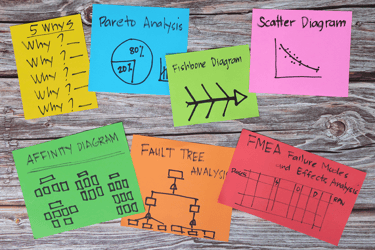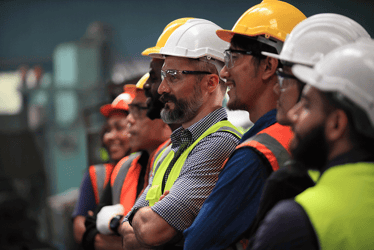The Packaging Industry's Sustainability Challenge: Why ERP Systems Are Essential for Success A straightforward guide to navigating sustainability regulations across folding carton, flexible...
What is Industry 5.0 & How Does it Differ from Industry 4.0?
Discover the revolutionary power of Industry 5.0 and how it is set to change the landscape beyond Industry 4.0.
TL;DR: Industry 5.0 builds upon Industry 4.0 by emphasizing human-centric, sustainable, and resilient manufacturing. While Industry 4.0 focuses on automation and the interconnectivity of machines through technologies like IoT and artificial intelligence (AI) , Industry 5.0 integrates human creativity and expertise with advanced technologies, fostering collaboration between humans and robots (cobots).
Contents
- The Evolution of Industrial Revolutions: From Industry 1.0 to 3.0
- Understanding Industry 4.0: The Digital Transformation
- What is Industry 5.0?
- What are the three pillars of Industry 5.0?
- How You Can Apply the Three Pillars of Industry 5.0 Strategically in Your Business
- Key Differences Between Industry 4.0 and Industry 5.0
- The Role of MES Applications in Industry 5.0
The Evolution of Industrial Revolutions: From Industry 1.0 to 3.0
Industry 1.0 (18th Century)
The Industrial Revolution started with Industry 1.0. This period was marked by the use of water and steam power for mechanization, a significant shift from agrarian economies to industrialized ones.
Industry 2.0 (19th Century)
Industry 2.0 introduced mass production and assembly lines powered by electricity. This period saw substantial improvements in productivity and efficiency.
Industry 3.0 (20th Century)
The rise of electronics, IT systems, and automation began in the late 20th century. Integrating computers and robotics into manufacturing processes signified a move towards more advanced automation and control.
Understanding Industry 4.0: The Digital Transformation
Industry 4.0, also known as the Fourth Industrial Revolution, emerged in the early 21st century. It combines advanced technologies like IoT, AI, big data, and cloud computing. These technologies enable smart factories with interconnected systems that communicate and optimize operations autonomously.
Industry 4.0’s digital transformation has dramatically improved customization, real-time decision-making, efficiency, and productivity. It has created new business models and made traditional manufacturing more flexible and adaptive.
What is Industry 5.0?
Industry 5.0 is the next step in industrial evolution, focusing on human-machine collaboration. Unlike Industry 4.0, which emphasizes automation and digitalization, Industry 5.0 brings the human touch back into manufacturing processes.
This era seeks to improve human abilities with robotics, AI, machine learning, big data, and other technologies, promoting collaboration between humans and machines. The goal is to achieve greater customization, creativity, and sustainability in production.
What are the three pillars of Industry 5.0?
The three pillars of Industry 5.0 are:
- Human-centric: This pillar focuses on workers' needs and creates safe, healthy, and fulfilling work environments.
- Resilience: This pillar concerns organizations’ anticipating, reacting to, and learning from challenges and crises. It also involves adapting to changing market conditions while maintaining high standards of quality and productivity.
- Sustainability: This pillar acknowledges that global industrial expansion trends cannot continue as they are. It requires companies to increase their positive impact and not just reduce their negative impact.
.png?width=1000&height=1000&name=Industry%205.0%20(2).png)
How You Can Apply the Three Pillars of Industry 5.0 Strategically in Your Business
Human-centric
A human-centric strategy focuses on “promoting talent, diversity, and empowerment.” This approach shifts the focus from seeing people as resources to seeing them as the primary beneficiaries of the organization’s purpose. In other words, it transforms the perspective from employees serving the organization to the organization serving its people.
Incorporating this shift into business strategy is more transformative than it initially appears. It aligns with pressing challenges in today’s job market, where attracting, developing, and retaining top talent has become more complex than maintaining customer loyalty in many industries. As this trend continues, organizations must adapt their strategies to prioritize human-centric principles—a core tenet of Industry 5.0.
Traditionally, strategy has centered on achieving a competitive edge to deliver exceptional value to customers, a concept pioneered by Michael Porter, one of the most influential figures in strategic thinking. However, adopting a genuinely human-centric approach redefines this focus. Businesses must aim to gain a competitive advantage by creating unparalleled value for their employees, ensuring they feel empowered, valued, and integral to the organization’s success.
By integrating these principles, companies can foster innovation, resilience, and long-term success, proving that prioritizing people isn’t just an ethical choice—it’s a strategic imperative.
Resilience strategy
The European Commission emphasizes that a resilient strategy is built on “agile and resilient with flexible and adaptable technologies.” In the wake of the COVID-19 pandemic, global supply chain shortages, and the war in Ukraine, few would dispute the growing importance of resilience—both today and in the future.
However, embracing resilience represents a deeper and more transformative shift than it may initially appear. While agility and flexibility have long been on corporate agendas, they don’t automatically equate to resilience. As previously discussed, today’s business strategies are predominantly driven by efficiency and profit optimization, often sidelining resilience. The emphasis on efficiency—particularly in its "lean" form—frequently prioritizes short-term gains, potentially reducing a company’s ability to withstand disruptions.
For resilience to become a cornerstone of Industry 5.0, the strategy must be rethought. The focus must move beyond growth, profit, and efficiency to building organizations that are “anti-fragile.” Such organizations don’t just withstand crises; they anticipate them, respond effectively, and learn systematically to emerge stronger. This shift will ensure stable, sustainable performance in an unpredictable world, redefining resilience as a strategic imperative rather than a byproduct of agility.
Sustainable Strategy
In today’s world, where concerns about climate change are universally recognized, sustainability needs little introduction. The European Commission says a sustainable strategy “leads action on sustainability and respects planetary boundaries.” This requires organizations to address all three Ps of the Triple Bottom Line—People, Planet, and Profit—and align with all 17 Sustainable Development Goals (SDGs).
Like the other pillars, this represents a profound transformation. Traditionally, corporate sustainability efforts have centered on minimizing harm—doing less damage—or, in some cases, engaging in superficial greenwashing. This approach reflects “business as usual,” albeit with a more responsible veneer.
However, fully integrating sustainability into a company’s strategy demands far more. Instead of merely reducing negative impacts, truly sustainable organizations aim to amplify their positive contributions.
In the context of Industry 5.0, sustainability means companies actively becoming part of the solution. They don’t just mitigate problems—they drive meaningful, positive change to build a better, more sustainable future for all.
What is the Difference Between Industry 4.0 and 5.0
While both Industry 4.0 and Industry 5.0 leverage advanced technologies, their core focuses differ. Industry 4.0 centers on automation, digital transformation, and integrating cyber-physical systems. Its primary objective is to create interconnected and autonomous production processes.
In contrast, Industry 5.0 represents human-centric solutions. It emphasizes the collaboration between humans and machines to enhance creativity, customization, and sustainability. The aim is to combine automation's efficiency with human workers' ingenuity and adaptability.
|
|
|
| Focus | Leveraging automation and technology to enhance manufacturing efficiency | Establishing sustainable and environmentally conscious manufacturing processes |
| Emphasis | Utilizing data and analytics to streamline and optimize operations | Highlighting the value of human interaction and collaboration |
| Competencies | Mastery of IoT, AI, and ML for automating tasks and decision-making | Blending advanced technologies with human creativity and expertise |
| Applications | Deploying robots and autonomous systems for precision, hazardous, or repetitive tasks | Empowering human workers through the development of advanced skills and competencies |
| Factories | Creating smart factories that self-optimize production processes | Designing integrated, adaptable systems to meet customer needs and respond to market trends |
| Technologies | Employing digital twins and simulation tools to refine production processes | Using cutting-edge technologies like nanotechnology and biotechnology to innovate materials and products |
| Efficiency | Achieving cost reductions through predictive maintenance and real-time monitoring | Focusing on sustainability and ethical practices to minimize waste and environmental impact |
Source: Atoss: From Industry 4.0 to Industry 5.0, August 2024.
The Role of MES Applications in Industry 5.0
Industry 5.0 brings the human element back into the spotlight - emphasizing collaboration between people and machines, personalization, and sustainability. Manufacturing Execution System (MES) applications are essential to realizing this shift.
Modern MES apps help manufacturers stay agile by connecting shop floor data with decision-makers in real time. In the context of Industry 5.0, these systems:
-
Empower human operators by surfacing actionable insights rather than raw data.
-
Enable mass customization by managing complex production workflows tailored to smaller batch sizes or personalized orders.
-
Support sustainability goals by tracking material usage, energy consumption, and waste in granular detail.
-
Build resilience by providing visibility across machines, labor, and supply chains - making it easier to adapt when disruptions hit.
As packaging manufacturers evolve beyond automation into this more balanced and human-first model, MES applications will act as a digital backbone - bridging high-level strategy with on-the-ground execution.




